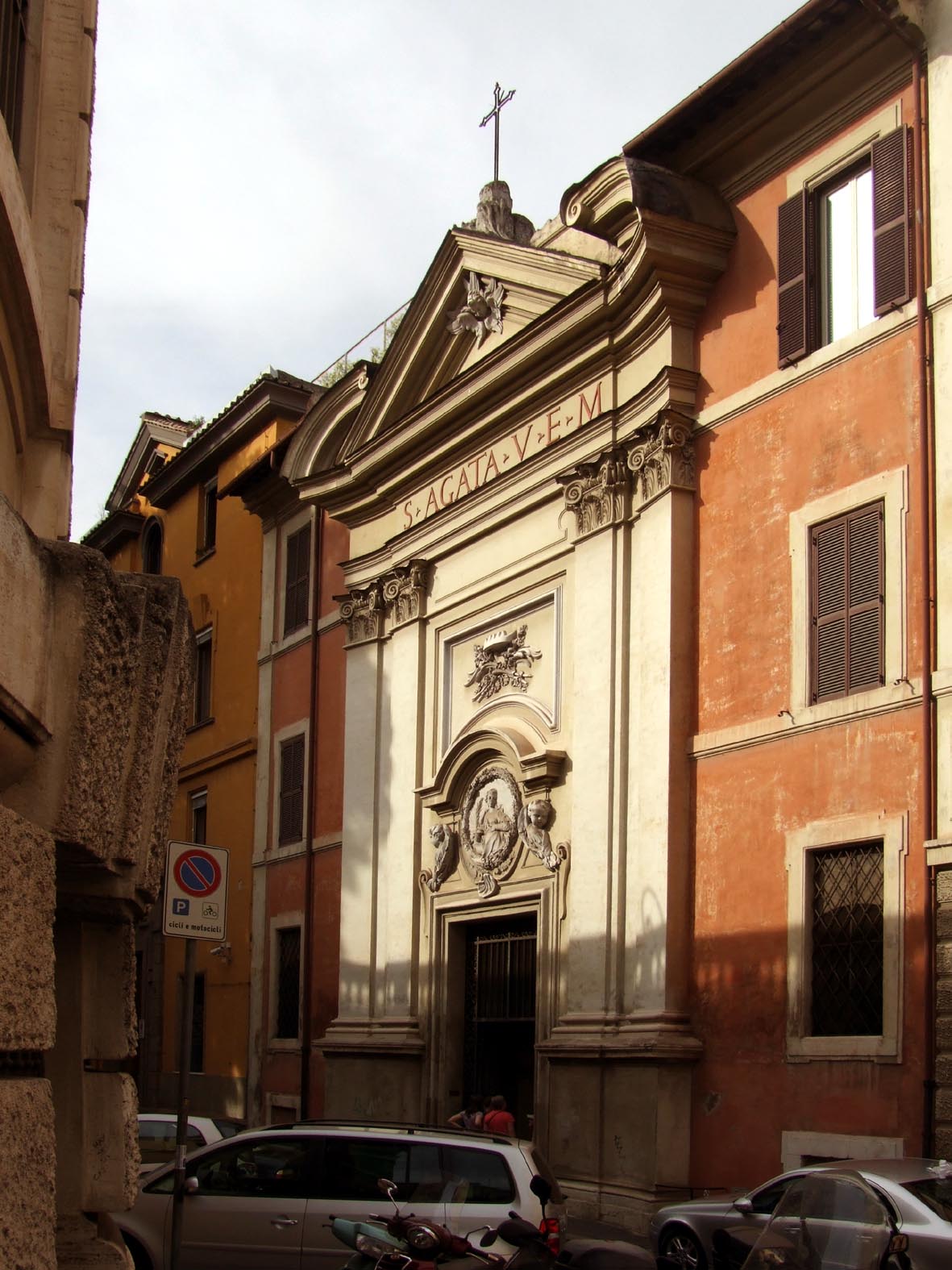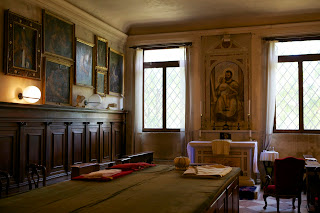A recent pilgrimage to Rome for the Year of Faith gave me an opportunity to re-visit some of the early Christian basilicas. There are the well-known basilicas of the first millennium of Christian history, such as Santa Sabina, Santa Prassede, and San Clemente, of course. But this time I also visited a lesser-known church just a stone's throw from where I was based in Rome at the Angelicum.
The church of Sant'Agata dei Goti (St Agatha of the Goths) was built in 462-70, and it has the distinction of being the only surviving church in Rome to have been built by the Arian Goths. It was re-consecrated for Catholic use by Pope St Gregory the Great in the 6th-century. Incidentally, this is currently the titular church of His Eminence Raymond Cardinal Burke.
The church retains its 5th-century plan, being a basilica with three naves, each terminating in an apse. Looking at an ancient Roman church like this, built for a relatively small community, it occurred to me that in this church one could see at least three features that inspired the classical Liturgical Movement.
Firstly, the Blessed Sacrament was reserved in a tabernacle in the apsidal chapel to the right of the main apse and Altar. Indeed, in almost every Roman church I visited (these being, in the main, churches from the first 1500 years of Christian history), the tabernacle was not reserved on the High Altar at all, but in a side chapel. I am conscious that this idea has not always been successfully applied in the modern era, and I am sympathetic of the desire to have the Blessed Sacrament most conspicuously prominent in a church. Nevertheless, there are ways of adopting the more ancient practice of Eucharistic reservation (i.e., somewhere other than on the main Altar) which are more successful than others, and they are worth bearing in mind, especially in the construction of new churches.
The location of the tabernacle in Sant'Agata dei Goti is particularly successful because the tabernacle is not hidden away but actually the first thing one encounters upon entering the church. This is because, as is often the case in ancient churches, one typically enters by the side, normally the liturgical south. In Sant'Agata, the south aisle (which is thus on the right of the central nave) terminates in an apsidal chapel in which the tabernacle is located.
Hence, one comes in by this side door, and immediately sees, to one's right, the Blessed Sacrament, and one, of course, genuflects and may go directly to visit the Lord. The entire south aisle, which is short and has a lower vault than the central nave, is effectively a side-chapel. The Eucharist is thus kept in a place that is distinct from the main Altar, but as the Code of Canon Law says: "prominent, conspicuous, beautifully decorated, and suitable for prayer".
The benefit of such an arrangement, of course, is that it makes the main Altar truly prominent, and it is further dignified by a simple but noble ciborium (baldachino). This combination of altar and ciborium is the second important feature of this church. The altar ciborium in Sant'Agata is medieval, dating from the 12th or 13th century. It was removed at some point but it was happily re-assembled and erected over the Altar in 1933, and is in very good condition. The Altar, as is so often the case in these early Christian churches, is free-standing and elevated but it is not lost in the apse, and made truly noble and beautiful by the baldachino. This, surely, must be the image we hold in mind when we think of free-standing stone altars in our new churches.
It is entirely possible, if one still desires to have the Blessed Sacrament reserved centrally, to use a hanging pyx. I don't think modern attempts of this medieval custom have been particularly successful but it can be done well, using ancient models, if we bear in mind that we only need a pyx large enough to reserve sufficient Hosts for the sick and for adoration of the Eucharist. After all, GIRM no.13 expresses the wish of the Second Vatican Council that communion during Mass should not come from presanctified Hosts reserved in the tabernacle but "from the same Sacrifice". As such, a larger pyx hanging over the Altar is not really necessary, although a larger tabernacle will be needed for the Triduum when presanctified Hosts are given in communion on Good Friday.
Thirdly, I noted the model of "unity by inclusion" found in Sant'Agata. Here, as in many of Rome's older churches, the early Christian style sits comfortably side-by-side with the medieval and Baroque. Hence the Second Vatican Council states: "The Church has not adopted any particular style of art as her very own; she has admitted styles from every period according to the natural talents and circumstances of peoples, and the needs of the various rites".
In the planning of a contemporary parochial church, I think there is much that we can learn from Sant'Agata dei Goti; much by which to be inspired.
The church of Sant'Agata dei Goti (St Agatha of the Goths) was built in 462-70, and it has the distinction of being the only surviving church in Rome to have been built by the Arian Goths. It was re-consecrated for Catholic use by Pope St Gregory the Great in the 6th-century. Incidentally, this is currently the titular church of His Eminence Raymond Cardinal Burke.
The church retains its 5th-century plan, being a basilica with three naves, each terminating in an apse. Looking at an ancient Roman church like this, built for a relatively small community, it occurred to me that in this church one could see at least three features that inspired the classical Liturgical Movement.
Firstly, the Blessed Sacrament was reserved in a tabernacle in the apsidal chapel to the right of the main apse and Altar. Indeed, in almost every Roman church I visited (these being, in the main, churches from the first 1500 years of Christian history), the tabernacle was not reserved on the High Altar at all, but in a side chapel. I am conscious that this idea has not always been successfully applied in the modern era, and I am sympathetic of the desire to have the Blessed Sacrament most conspicuously prominent in a church. Nevertheless, there are ways of adopting the more ancient practice of Eucharistic reservation (i.e., somewhere other than on the main Altar) which are more successful than others, and they are worth bearing in mind, especially in the construction of new churches.
The location of the tabernacle in Sant'Agata dei Goti is particularly successful because the tabernacle is not hidden away but actually the first thing one encounters upon entering the church. This is because, as is often the case in ancient churches, one typically enters by the side, normally the liturgical south. In Sant'Agata, the south aisle (which is thus on the right of the central nave) terminates in an apsidal chapel in which the tabernacle is located.
Hence, one comes in by this side door, and immediately sees, to one's right, the Blessed Sacrament, and one, of course, genuflects and may go directly to visit the Lord. The entire south aisle, which is short and has a lower vault than the central nave, is effectively a side-chapel. The Eucharist is thus kept in a place that is distinct from the main Altar, but as the Code of Canon Law says: "prominent, conspicuous, beautifully decorated, and suitable for prayer".
The benefit of such an arrangement, of course, is that it makes the main Altar truly prominent, and it is further dignified by a simple but noble ciborium (baldachino). This combination of altar and ciborium is the second important feature of this church. The altar ciborium in Sant'Agata is medieval, dating from the 12th or 13th century. It was removed at some point but it was happily re-assembled and erected over the Altar in 1933, and is in very good condition. The Altar, as is so often the case in these early Christian churches, is free-standing and elevated but it is not lost in the apse, and made truly noble and beautiful by the baldachino. This, surely, must be the image we hold in mind when we think of free-standing stone altars in our new churches.
It is entirely possible, if one still desires to have the Blessed Sacrament reserved centrally, to use a hanging pyx. I don't think modern attempts of this medieval custom have been particularly successful but it can be done well, using ancient models, if we bear in mind that we only need a pyx large enough to reserve sufficient Hosts for the sick and for adoration of the Eucharist. After all, GIRM no.13 expresses the wish of the Second Vatican Council that communion during Mass should not come from presanctified Hosts reserved in the tabernacle but "from the same Sacrifice". As such, a larger pyx hanging over the Altar is not really necessary, although a larger tabernacle will be needed for the Triduum when presanctified Hosts are given in communion on Good Friday.
Thirdly, I noted the model of "unity by inclusion" found in Sant'Agata. Here, as in many of Rome's older churches, the early Christian style sits comfortably side-by-side with the medieval and Baroque. Hence the Second Vatican Council states: "The Church has not adopted any particular style of art as her very own; she has admitted styles from every period according to the natural talents and circumstances of peoples, and the needs of the various rites".
In the planning of a contemporary parochial church, I think there is much that we can learn from Sant'Agata dei Goti; much by which to be inspired.














































